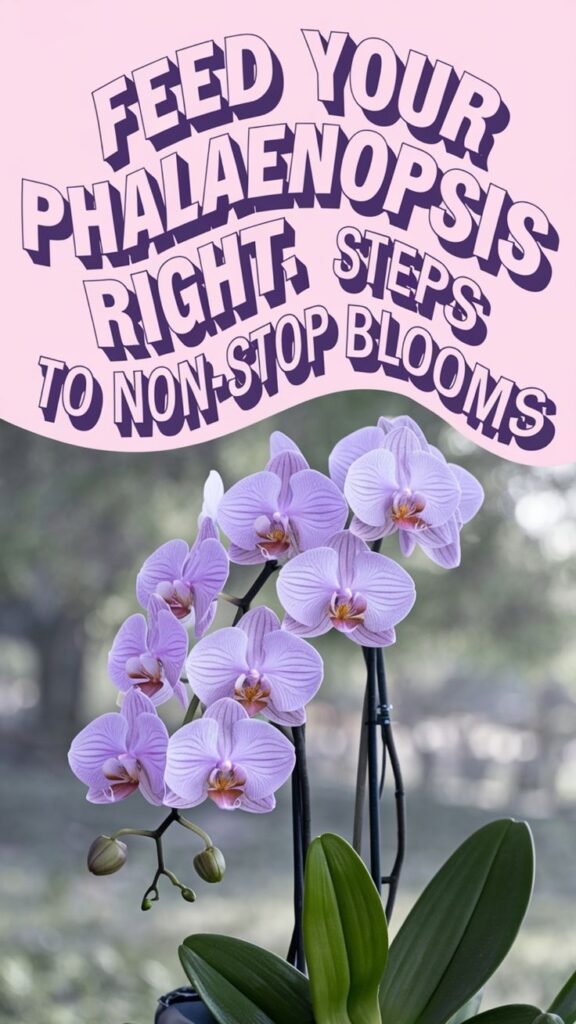You’ve probably noticed your Phalaenopsis orchid isn’t blooming as vibrantly as it used to. While these elegant plants aren’t particularly demanding, they do need proper nutrition to produce those stunning blooms you’re hoping for. The secret lies in understanding when and how to fertilize – it’s not just about tossing some plant food their way every now and then. Let’s explore the precise feeding schedule and formula choices that’ll transform your orchid from merely surviving to absolutely thriving.

Contents
Understanding Phalaenopsis Orchid Nutrient Needs
While Phalaenopsis orchids aren’t heavy feeders, they do require specific nutrients to thrive and produce their stunning blooms. Your orchid needs three primary nutrients: nitrogen (N) for leaf growth, phosphorus (P) for root development, and potassium (K) for flower production.
Look for a balanced fertilizer with an NPK ratio of 20-20-20 or 10-10-10, which provides these essential nutrients in equal proportions. During the growing season, from spring through fall, you’ll want to feed your orchid every two weeks with a quarter-strength solution, while reducing to monthly feedings in winter when growth naturally slows.
Choosing the Right Fertilizer Formula
Although many orchid fertilizers claim to be “the best,” selecting the right formula depends primarily on your growing conditions and your plant’s current stage of growth. For most Phalaenopsis orchids, you’ll want a balanced 20-20-20 fertilizer or a nitrogen-reduced 10-30-20 blend during blooming season.
When selecting your fertilizer, look for products labeled “urea-free,” as orchids can’t process this form of nitrogen effectively. You’ll also want to guarantee the formula contains trace minerals like calcium, magnesium, and iron. If you’re growing under artificial lights, choose a formula with slightly higher phosphorus content to promote stronger blooming.
Best Times to Feed Your Orchids
Since Phalaenopsis orchids have distinct growing cycles, you’ll need to adjust your feeding schedule throughout the year. During the active growing season, from spring through fall, fertilize every two weeks with a balanced, water-soluble orchid formula at quarter strength.
Reduce feeding to once monthly in winter when your orchid’s growth naturally slows. Skip fertilizing altogether when your plant is blooming, as this can shorten flower life. If you’ve recently repotted your orchid, wait three weeks before resuming fertilization to avoid stressing the recovering root system.
Always fertilize in the morning, and only feed when the growing medium is slightly moist.
Proper Fertilizer Application Methods
Following the right timing, you’ll want to master proper application techniques for ideal results. Always dilute fertilizer to 1/4 strength of what’s recommended on the label, mixing thoroughly with room-temperature water.
Apply the solution when the potting medium is slightly moist, never bone dry. Pour the diluted fertilizer evenly around the base of your orchid, avoiding the crown and leaves. For mounted orchids, mist the roots directly until they turn green.
Once monthly, flush the growing medium with plain water for 1-2 minutes to prevent salt buildup. This “washing” helps maintain healthy roots and prevents fertilizer burn.
Signs of Over and Under Fertilizing
Keeping a watchful eye on your orchid’s health will reveal telltale signs of fertilizer imbalances. When you’ve over-fertilized, you’ll notice brown leaf tips, crusty white mineral deposits on the potting media, and yellowing leaves with dark spots. The roots may appear brown and dried out.
Under-fertilizing shows up as pale, yellowing leaves, especially on new growth. You’ll see slower growth rates, smaller leaves, and fewer blooms than usual. The plant might also produce weak, spindly flower spikes that fail to support blooms properly.
If you spot these signs, adjust your fertilizing routine immediately. Remember, it’s easier to correct under-fertilizing than to repair damage from over-fertilizing.
Seasonal Fertilizing Adjustments
While your orchid’s fertilizer needs fluctuate throughout the year, you’ll need to adjust feeding schedules based on seasonal growth patterns. During spring and summer’s active growth phase, fertilize every 2-3 weeks with a balanced 20-20-20 solution at quarter strength.
Cut back to monthly feeding in fall, using a lower nitrogen formula like 10-30-20. In winter, when your orchid’s naturally resting, reduce fertilizing to every 6-8 weeks. If your Phalaenopsis is spiking or blooming, switch to a “blossom booster” formula high in phosphorus.
Remember to adjust these schedules if you’re growing indoors under artificial lights, as your orchid’s growth cycles might differ.
Special Feeding Requirements During Blooming Cycles
Once your Phalaenopsis orchid begins developing flower spikes, it’s time to modify your feeding routine. Reduce nitrogen-heavy fertilizers to 1/4 strength, and switch to a bloom-boosting formula with higher phosphorus content (such as 3-12-6) to support flower development.
During the blooming phase, you’ll want to fertilize every other week instead of weekly. Apply the solution only when the growing medium is slightly moist, never bone dry. If your orchid’s blooms last longer than two months, give it a dose of magnesium sulfate (1/4 teaspoon per gallon) monthly to prevent yellowing leaves and maintain vibrant flowers.
